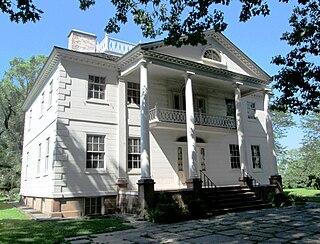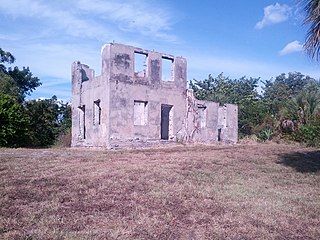
Jacksonville is the most populous city in Florida, and is the largest city by area in the contiguous United States as of 2020. It is the seat of Duval County, with which the city government consolidated in 1968. Consolidation gave Jacksonville its great size and placed most of its metropolitan population within the city limits. As of 2021, Jacksonville's population was estimated to be 929,647, making it the 13th most populous city in the U.S., the most populous city in the Southeast, and the most populous city in the South outside of the state of Texas. The Jacksonville metropolitan area has a population of 1,523,615 and is the fourth largest metropolitan area in Florida.

The Morris–Jumel Mansion or Morris House (also known as the Roger and Mary Philipse Morris House, "Mount Morris" and Morris–Jumel Mansion Museum is a Federal style museum home in northern Manhattan with mid-eighteenth century roots. It was built in 1765 by Roger Morris, a British military officer, and served as a headquarters for both sides in the American Revolution.

The Judah P. Benjamin Confederate Memorial at Gamble Plantation Historic State Park, also known as the Gamble Mansion or Gamble Plantation, is a Florida State Park, located in Ellenton, Florida, on 37th Avenue East and US 301. It is home to the Florida Division United Daughters of the Confederacy (UDC).

The St. Johns Light is an active lighthouse in Jacksonville, Florida, marking the mouth of the St. Johns River. Built in 1954, it is located on Naval Station Mayport in the Mayport area. It was erected to replace a lightship, which itself replaced the still-standing Old St. Johns River Light. It is the fourth lighthouse built at the mouth of the St. Johns since 1830. It was listed on the National Register of Historic Places in 2018.

Tudor Place is a Federal-style mansion in Washington, D.C. that was originally the home of Thomas Peter and his wife, Martha Parke Custis Peter, a granddaughter of Martha Washington. Step-grandfather George Washington left her the $8,000 in his will that was used to purchase the property in 1805. The property, comprising one city block on the crest of Georgetown Heights, had an excellent view of the Potomac River.

Downtown Jacksonville is the historic core and central business district (CBD) of Jacksonville, Florida USA. It comprises the earliest area of the city to be developed and is located in its geographic center along the narrowing point of the St. Johns River. There are various definitions of what constitutes Jacksonville's downtown; the one used by the city government and other entities defines it as including eight districts: the Central Core, the Southbank, LaVilla, Brooklyn, the Working Waterfront, the Cathedral, the Church, and the Entertainment & Sports District. The area features offices for major corporations such as CSX Corporation, Fidelity National Financial, TIAA Bank, Black Knight Financial, One Call Care Management, Suddath, Interline Brands Haskell, FIS, and Stein Mart.

Ortega is a neighborhood of Jacksonville, Florida, US. It is located south of downtown Jacksonville on a peninsula off the western bank of the St. Johns River. It is one of the wealthiest neighborhoods in Jacksonville, and is the location of many historic homes and buildings.

The Thomas V. Porter House is a historic home in Jacksonville, Florida. It is located at 510 Julia Street, and was designed by New York City architect Henry John Klutho. On May 13, 1976, it was added to the U.S. National Register of Historic Places.

The Epping Forest was a historic, 58-acre (230,000 m2) estate in Jacksonville, Florida where a luxurious riverfront mansion was built in the mid-1920s by industrialist Alfred I. du Pont and his third wife, Jessie Ball du Pont. It was added to the U.S. National Register of Historic Places in 1973 and has been restored to its original grandeur as the home of the Epping Forest Yacht Club. On April 18, 2012, the AIA's Florida Chapter placed the Epping Forest Yacht Club on its list of "Florida Architecture: 100 Years. 100 Places".

Tuckahoe, also known as the Leach Mansion or as the Mansion at Tuckahoe, is an historic home located at 1921 North East Indian River Drive in Jensen Beach, Martin County, Florida. The name was thought to be a Native American word for "welcome". It is inside the present day Indian RiverSide Park and is atop the Mount Elizabeth Archeological Site, which was added to the National Register of Historic Places on September 14, 2002.

The Moses Fowler House is located at the corner of 10th and South streets in Lafayette, Indiana. The house is considered the finest example of a large Gothic Revival residence still standing in the United States. Upon his death in 1889, aged 74, Fowler had accumulated a fortune of an estimated three million dollars. Fowler and his wife, Eliza (1817–1902), were donors to various community interests, including Purdue University.

Point of Honor is an historic home, now a city museum, located in Lynchburg, Virginia. The property has commanding views of the city and the James River. Its name originated due to the land on which it is built being used as a clandestine dueling ground.

Wilbur B. Talley was an architect in Florida. He worked in Jacksonville until the death of his wife Nellie and daughter Sarah, who were riding in a car hit by a train on December 21, 1919. After the accident, he moved to Lakeland, Florida where he continued working as an architect.
The following is a timeline of the history of the city of Jacksonville, Florida, USA.

Captain John Foley Horr was a resident and owner of Horr's Island located at the southern end of Marco Island, Florida. He was one of the notable federal officials in the State of Florida.

Evergreen Cemetery is a historic cemetery in Jacksonville, Florida. It was added to the National Register of Historic Places on April 8, 2011. It is located at 4535 North Main Street, in the city's Northside area.
Thomas Basnett (1808–1886) was a prominent British astronomer and meteorologist. He built Marabanong in the Jacksonville, Florida area and married Eliza Wilbur in his third marriage. Basnett moved from England to Illinois in 1835 and ran a drugstore. Circa 1876 he constructed Marabonong on a promontory above the St. Johns River near Jacksonville, Florida
Eliza Madelina Wilbur Souvielle was a prominent scientist, astronomer, botanist, inventor, author and publisher.

The architecture of Jacksonville is a combination of historic and modern styles reflecting the city's early position as a regional center of business. According to the National Trust for Historic Preservation, there are more buildings built before 1967 in Jacksonville than any other city in Florida, but it is also important to note that few structures in the city center predate the Great Fire of 1901. Numerous buildings in the city have held state height records, dating as far back as 1902, and last holding a record in 1981.
The cape of Point La Vista is a bluff in Duval County, located on the eastern bank of the St. Johns River, three miles south of downtown Jacksonville, Florida. It is also the name of one of the subdivisions on the cape. This residential community of single-family homes was created during suburban expansion from the mid-1920's through the 1980s on one of the city's most geographically distinct riverfront locations. The historical boundaries of the cape of Point La Vista date from land grants of the Second Spanish Era (1783-1821). The modern half-loop road of San Jose Blvd. splits off of Hendricks Avenue just after River Oaks Park, the old Oriental Gardens, at Southside United Methodist Church and hugs the pedestrian-friendly contours of the cape for nearly two miles, ending at the Miramar Center, a shopping plaza. The portion of the cape within the old Jacksonville city limits of 1937 overlaps the traditional southern boundary of the San Marco neighborhood. Many places in Duval County are named for families who once owned property at the cape, such as Bowden Road, Shad Road, Sanchez Road, Hendricks Avenue, Philips Highway, and the Hart Bridge.


















